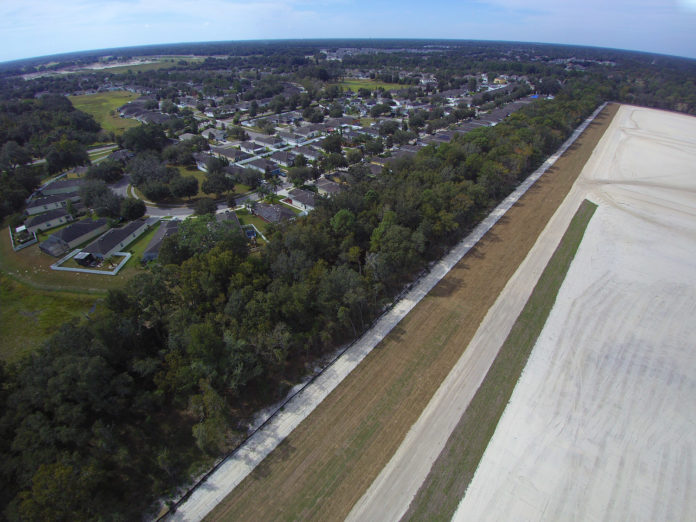Inside the existing Airport Water Reclamation Facility (WRF) at Brooksville Airport Industrial Park on Downwind Way, huge pipes lay perched above ditches where workers will connect them to their respective holding ponds before burying. Since its inception, the sewerage expansion project (in County Commissioner Jeff Holcomb’s District 4) drew the concern of many residents when they learned the aquifer recharge ponds would be close to the backyards where their children play. The total distance between Trillium properties and the ponds will be over 200’, according to a letter from the county Utilities Department.
The department also explained that the plant will receive wastewater and turn it into reclaimed water. The water being discharged into the new aquifer recharge ponds is the same reclaimed water that could be used to irrigate parks, golf courses, and residential lawns. The aquifer recharge ponds sustain groundwater levels for the County and assist with maintaining the minimum flows and levels (MFLs) of the nearby lakes and springs.
To alleviate the concerns expressed by many Trillium residents and nearby property owners, Trillium HOA President Dan A. Isbell assured Trillium homeowners in an open letter that the sewer-treatment retention ponds behind Wake Robin Drive pose no risks to property or residents:
“I have some prior experience with Fresh Water and Waste Water Treatment Plants in Florida. The bottom line up front is that the currently planned/funded expansion of the Airport WWTP is most definitely required, has been on the books for many years now, and will not have negative impacts on our HOA community,” Isbell said.
It is unclear what qualified Mr. Isbell to make such a statement.
Most days, Trillium residents awake to the sound of bulldozers and dump trucks. Florida law states that public sewer facilities can build retention ponds up to 50 feet from property lines, according to Chapter 62-610 of the Florida Administrative Code, but this is not an average distance.
While all parties concerned agree Hernando County must significantly expand its ability to treat sewerage safely, some believe that building water reclamation ponds so close to a highly populated community may cause ground and or airborne contaminants or lower property values. Over 500 community members signed a petition to halt construction before crews ever broke ground.
A 125-foot line of trees provides a buffer between back yards and the aforementioned ponds. The ponds will be enclosed by a continuous six-foot-high security fence.
The Utilities Department states that the project will include filtration beyond what regulations require. A “technologically advanced” step feed process will use a biological process to treat the wastewater. Prior to being released to the aquifer recharge ponds, the wastewater will be disinfected a final time with liquid bleach as opposed to gaseous chlorine. There will also be improvements to the existing odor control unit at the WRF entrance during the current expansion.
A priority and major component of the phase 3 expansion is to reduce Nitrogen levels in and around Weeki Wachee Springs and the river. However, the information provided by the Utilities Department does not specifically address the potential effects that the massive collection of reclamation ponds might have on residents residing on just the other side of Trillium’s white, vinyl fence.
The expansion project is required to meet Florida’s Advanced Wastewater Treatment (AWT) standards for total Nitrogen which is 3 mg/l in the focus area of Weeki Wachee Springs. Concerned residents think the county should have built the ponds in a less populated area and pipe the reclamation water away from the chosen densely populated site.

The joint plan includes decommissioning the outdated Osowaw Boulevard WRF and piping that sewerage to the expanded Airport WRF. The plan also includes hundreds of mandatory conversions (from septic tank to public utility service) within the Weeki Wachee basin area and Spring Hill.
Hernando County was granted state funding of $12.9 million of the total estimated construction cost of $24.2 million for sewer improvements. The expansion of the Airport WRF increases plant capacity from 3.5 million gallons per day (MGD) to 6 million MGD and is expected to sustain the county for at least the next 20 years. The expansion should be complete in 2023.
Editor’s Note: The author of this article is a resident of Trillium.






